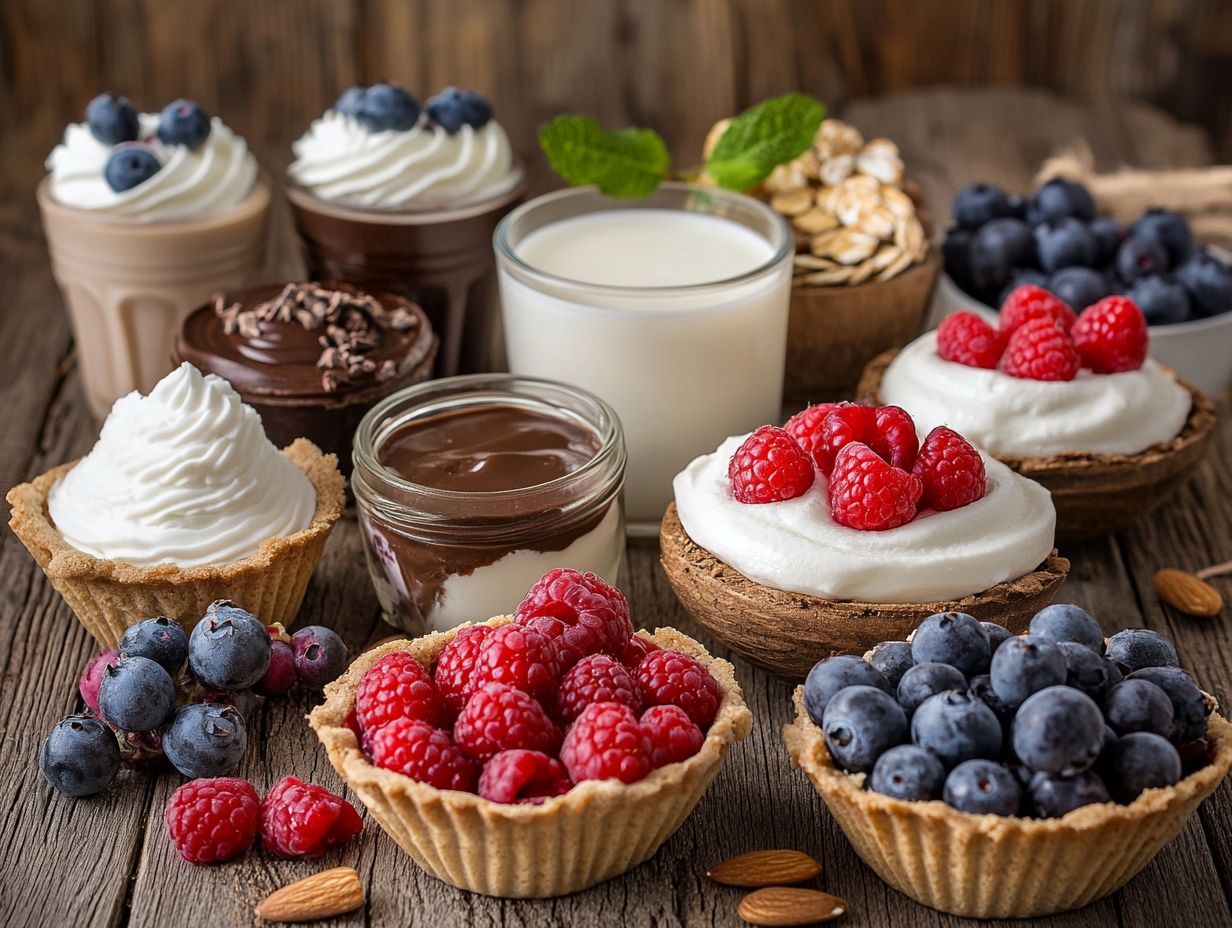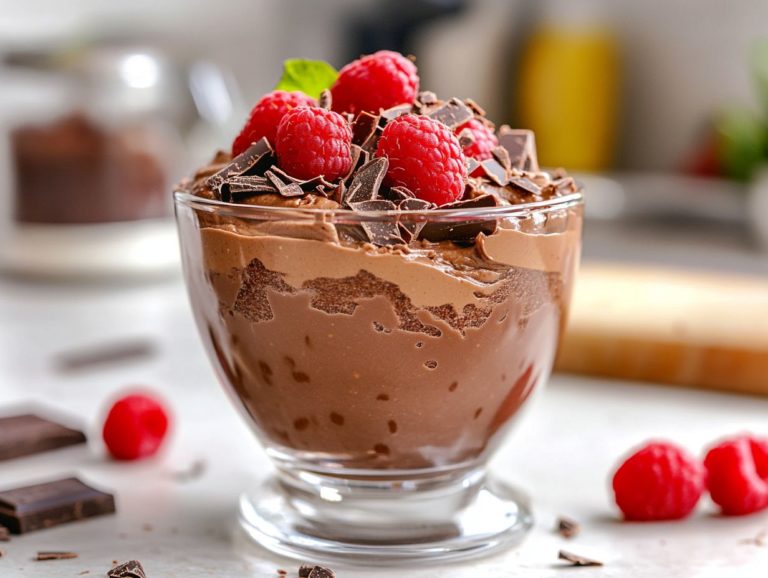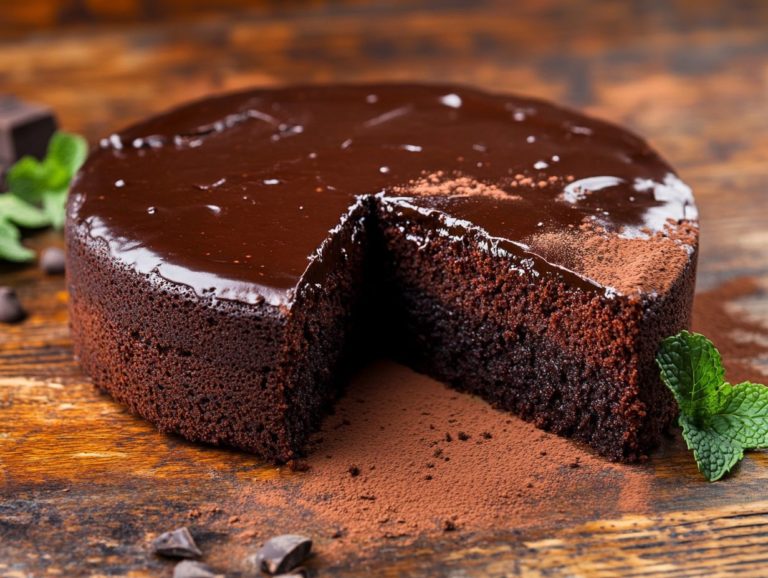What Are the Best Dairy Substitutes for Desserts?
Are you on a quest to satisfy your sweet tooth while steering clear of dairy? Whether you’re lactose intolerant, embracing a vegan lifestyle, or simply eager to explore new cooking ideas, discovering the perfect dairy substitutes for desserts can unlock a realm of delightful possibilities. This quest can also include finding the perfect host gift or holiday table centerpiece that everyone can enjoy.
You ll uncover the finest non-dairy alternatives such as coconut, almond, and oat milk, along with expert tips for baking with these substitutes. Imagine creating a delicious peach pie or delightful peppermint divinity using these milk options.
You ll also find a comparison of their nutritional value and taste against traditional dairy, as well as a collection of irresistible dairy-free dessert recipes that you absolutely won t want to overlook! From homemade marshmallows to Passover macaroons, the possibilities are endless.
Contents
- Key Takeaways:
- Why Use Dairy Substitutes in Desserts?
- What Are the Best Non-Dairy Substitutes for Desserts?
- Popular Dairy-Free Milk Alternatives
- What Are Some Tips for Baking with Non-Dairy Substitutes?
- How Do These Substitutes Compare to Dairy in Terms of Nutrition and Taste?
- What Are Some Delicious Dairy-Free Dessert Recipes to Try?
- 1. Vegan Chocolate Cake
- 2. Dairy-Free Cheesecake
- 3. Coconut Milk Ice Cream
- 4. Almond Milk Pudding
- Frequently Asked Questions
- What Are the Best Dairy Substitutes for Desserts?
- What are some common dairy substitutes for baking desserts?
- Are there any dairy alternatives that provide a similar texture and flavor to traditional dairy products?
- What are some dairy-free options for making creamy desserts?
- Can you make dairy-free desserts using fruit as a replacement for sugar?
- Are There Vegan Options for Dairy-Free Desserts?
Key Takeaways:

- Consider dairy substitutes for desserts to accommodate dietary restrictions or preferences. These options are perfect for restricted diets and those with food allergies.
- The top non-dairy options for desserts are coconut, almond, cashew, oat, and soy milk. Other nut milk options like hazelnut milk and macadamia milk can also be fantastic substitutes.
- Tips for baking with non-dairy substitutes include adjusting consistency, adding flavorings like vanilla extract, and using non-dairy butter alternatives.
Why Use Dairy Substitutes in Desserts?
Desserts are often the highlight of any meal, especially during holidays and family gatherings. Consider using dairy substitutes for a cozy flavor that everyone will love.
Explore dairy substitutes for exquisite desserts that meet dietary needs, whether it s for a dairy-free, vegan lifestyle, or specific restrictions due to food allergies.
Embracing non-dairy options not only accommodates those who are dairy-intolerant but also invites an array of creative and delightful recipes that can satisfy every palate, whether at a festive holiday gathering, an intimate family dinner, or a Southern Living inspired Thanksgiving meal.
Get ready to indulge in rich flavors and sumptuous textures by selecting ingredients like almond milk or coconut milk, ensuring that your treats are welcoming to guests with dietary sensitivities or preferences.
What Are the Best Non-Dairy Substitutes for Desserts?
By Mary Shannon Wells
Photography by Antonis Achilleos, Greg DuPree, and Jennifer Causey
As you delve into the realm of dairy-free desserts, it s crucial to grasp the finest non-dairy substitutes that can elevate your sweet creations without sacrificing flavor or texture.
Ingredients such as coconut milk, almond milk, and cashew milk serve as superb foundations for an array of desserts, enabling you to craft everything from decadent flourless chocolate cakes to light and airy homemade marshmallows.
Additionally, oat milk and soy milk present valuable alternatives for those with various dietary needs, ensuring that everyone can revel in delectable desserts without concern for food allergies or dairy sensitivities.
Popular Dairy-Free Milk Alternatives
1. Coconut Milk
Coconut milk is your go-to, versatile, dairy-free alternative that introduces a rich, creamy texture to desserts. It’s an absolute favorite for anyone looking to savor comfort foods without the dairy. Whether you re making Mama Mae’s Ambrosia or a gelatin salad, coconut milk is an excellent choice.
Coconut milk adds a hint of tropical flavor to the table and plays beautifully in a variety of recipes. From coconut milk ice cream to spiced pumpkin pie, it ensures a cozy taste that everyone will love.
When you incorporate coconut milk into your baking, you elevate the entire sensory experience while reaping a wealth of nutritional benefits, including healthy fats and essential vitamins. This ingredient truly shines in Southern desserts, transforming traditional delights like bread puddings and cakes into scrumptious, dairy-free versions that don t compromise on flavor.
Its subtle sweetness and unique flavor profile blend seamlessly with spices like cinnamon and nutmeg, creating a delightful harmony that dances on the palate. Plus, it serves as an excellent substitute for regular milk in classic recipes, delivering a creamy consistency that captivates even the most discerning taste buds.
With its rising popularity, coconut milk has become an essential pantry staple for anyone eager to explore innovative cooking ideas.
2. Almond Milk
Almond milk stands out as a remarkable non-dairy alternative, cherished for its subtle nutty flavor and incredible versatility in both baking and cooking. From blueberry-plum pops to angel food cake, this dairy-free marvel effortlessly replaces traditional milk in a myriad of recipes, maintaining a delightful taste that complements sweet treats.
It s perfect for whipping up light desserts like almond milk pudding or blending into smoothies. You can create anything from blueberry-plum pops to decadent chocolate cake.
Not only does almond milk add a creamy texture, but it also infuses baked goods with a lovely hint of nuttiness, enhancing the overall flavor profile. With its lower calorie count and reduced fat content, it s an enticing choice for those pursuing healthier dessert options. It still delivers essential nutrients like vitamin E and calcium.
In popular recipes, such as almond milk cheesecake or banana almond milk muffins, this versatile ingredient truly shines. It harmonizes beautifully with flavors like vanilla, chocolate, and fruit, resulting in indulgent yet health-conscious desserts that everyone can savor.
3. Cashew Milk
Cashew milk truly shines as a rich and creamy dairy-free alternative, perfect for those who crave a luxurious texture in their desserts without the dairy. It s often featured in recipes like dairy-free cheesecake or used as a base for creamy sauces, elevating the overall indulgence of your sweet creations.
You ll love the subtly sweet flavor of this non-dairy milk! It makes it especially delightful in s smoothies and coffee, giving it an edge over other alternatives like almond or coconut milk. It also pairs wonderfully with desserts like Southern foods or flourless desserts.
Its creamy consistency is ideal for crafting sumptuous soups, delivering the same satisfying mouthfeel as heavy cream minus the guilt.
Regarding baking, cashew milk contributes moisture and richness to your recipes, working beautifully in cakes and muffins. For a delectable treat, why not whip up a cashew milk chocolate pudding or a savory cashew-based alfredo sauce? You’ll impress even the most discerning palates with these delightful dishes.
Try these milk alternatives in your cooking and baking for a delightful twist on your favorite recipes!
4. Oat Milk

Photography by Greg DuPree, Jennifer Causey
Oat milk has swiftly become a beloved dairy-free alternative, celebrated for its creamy texture and gentle flavor. It s perfect for elevating a variety of desserts. Whether you’re whipping it into baking recipes or using it as a base for non-dairy yogurt, oat milk adds a comforting touch to your creations. It enhances both flavor and texture while accommodating those with food allergies.
It s also an excellent choice for making gluten-free desserts, like oat milk pancakes. This versatile ingredient is not just for sweet indulgences like cookies and cakes; it truly shines in savory dishes as well. It imparts a subtle nutty flavor that complements a wide array of cuisines.
Imagine crafting creamy oat milk pancakes drizzled with syrup or creating rich, savory sauces and soups with it the possibilities are truly exciting! Its ability to blend effortlessly into recipes offers a lighter, healthier alternative to traditional dairy products, fostering a more inclusive approach to your culinary adventures.
As more people explore plant-based options, oat milk’s warm flavor profile has established it as a kitchen staple. It appeals to both vegans and anyone looking to cut back on dairy.
5. Soy Milk
Photography by Jennifer Causey
Soy milk is a celebrated non-dairy alternative, rich in protein and a staple in many vegan diets. Its versatility allows you to seamlessly incorporate it into various recipes, from chocolate meringue cookies to luscious custards. It offers a satisfying texture and flavor that can effortlessly replace traditional dairy products.
Soy milk offers an impressive nutritional profile, complete with important nutrients our bodies need. It also serves as an exceptional base for creamy ice creams and puddings. If you re lactose intolerant or choose to avoid dairy for ethical reasons, this plant-based option becomes a dependable substitute in your favorite recipes.
When baking, soy milk can easily replace cow’s milk in muffins or cakes, ensuring a moist and delightful outcome without sacrificing taste. Compared to other non-dairy alternatives like almond or oat milk, soy milk truly shines with its higher protein content. This makes it an attractive choice for those seeking a more nutrient-rich option. Try using it in recipes for soft and chewy chocolate meringue cookies.
What Are Some Tips for Baking with Non-Dairy Substitutes?
Baking with non-dairy substitutes demands a few thoughtful adjustments to ensure your desserts strike the perfect balance of texture and flavor. This is especially important when accommodating dietary preferences like dairy-free or vegan diets. Think of Southern Living inspired passover macaroons or Louisiana style brown sugar frosting that everyone will enjoy.
With some strategic tweaks to your recipes, you can whip up delightful treats. Imagine flourless desserts or luscious layer cakes that everyone will love! Key tips include modifying for a thicker consistency, enhancing flavors with additional ingredients, and opting for non-dairy butter alternatives. These will help preserve that cherished comfort food essence.
1. Adjust for Thicker Consistency
When using non-dairy substitutes, it’s essential to adjust your recipes for a thicker consistency. Many alternatives, like almond milk or coconut milk, bring different textures to the table compared to traditional dairy. This adjustment is crucial for achieving the desired outcome in desserts such as angel food cake or spiced pumpkin pie. It ensures they retain their intended structure and flavor. Consider adding crunchy toppings or a drizzle of caramel for extra texture and a caramelized flavor.
To achieve the right thickness, consider using plant-based cream or mixing non-dairy milk with a thickening agent like cornstarch or arrowroot powder. For example, when swapping out heavy cream in a creamy pie filling, you might opt for full-fat coconut cream or blend silken tofu with a splash of non-dairy milk to capture that richness.
You might also find that slightly increasing the amount of flour or incorporating ground flaxseeds enhances the structure of your baked goods. This strategy not only preserves the integrity of your dish but also harmonizes beautifully with the flavors. It allows the natural sweetness of the ingredients to shine through.
2. Add Extra Flavorings
Incorporating extra flavorings is an invaluable tip when you’re baking with non-dairy substitutes. These ingredients can truly enhance the overall taste of your desserts.
Imagine adding a splash of vanilla extract, a hint of cocoa, or a sprinkle of spices to elevate your creations. This technique works wonders whether you’re whipping up chocolate meringue cookies or a comforting caramelized dessert.
To really take those flavors to the next level, consider experimenting with citrus zest. This can provide a refreshing twist to your fruity pastries or creamy puddings.
Introducing nut butters or coconut cream can also add richness and depth, especially in chocolate-based recipes. Picture a luscious peanut butter swirl in a non-dairy brownie; it s a delightful contrast that will excite your palate.
And don t overlook herbs like mint or rosemary these can lend an unexpected yet delightful note, particularly in sorbets and cakes. With these flavorful additions, any non-dairy dessert you create can become a delectable masterpiece.
3. Use Non-Dairy Butter Alternatives
Using non-dairy butter alternatives is crucial for achieving that perfect texture and richness in your baking while avoiding traditional dairy products. Options like vegan butter or coconut oil can seamlessly replace regular butter in your recipes, ensuring a rich texture while creating delicious desserts, from layered cakes to decadent brownies.
Among the myriad of substitutes, avocado oil particularly shines with its creamy texture and mild flavor, making it an excellent choice for cookies or muffins where moisture is paramount.
If you re in the mood for a nutty twist, almond or cashew butter can elevate the flavor profile in delightful treats like blondies.
It s essential to recognize that these alternatives may slightly alter baking times or required temperatures, as they can behave differently in your recipes. Experimenting with non-dairy options not only expands your flavor horizons but also accommodates various dietary needs.
Consider trying a simple chocolate chip cookie recipe, swapping out regular butter for coconut oil, or bake a rich carrot cake using vegan butter for a result that s effortlessly delicious.
How Do These Substitutes Compare to Dairy in Terms of Nutrition and Taste?
When assessing dairy substitutes in terms of both nutrition and flavor, it s crucial to examine how options such as coconut milk, almond milk, and soy milk compare to traditional dairy products.
Some non-dairy alternatives might boast fewer calories or lower fat content, while others can deliver similar protein levels, making them enticing choices for individuals following a vegan diet or those with dairy sensitivities.
The flavor profiles of these substitutes differ significantly, which can influence the overall taste of your beloved desserts and comfort foods.
1. Nutritional Value

The nutritional value of dairy substitutes like almond milk, soy milk, and coconut milk can vary significantly, shaping their versatility in your cooking and baking endeavors.
For instance, almond milk is often lower in calories and fat, making it a lighter choice. Soy milk typically boasts a higher protein content, catering to different dietary needs and preferences you might have.
Coconut milk, on the other hand, adds a luscious, creamy texture to desserts, but it usually comes with a higher saturated fat content, which may not suit everyone’s dietary goals.
To give you a clearer picture, almond milk averages about 30-40 calories per cup, while soy milk rings in at around 80-100 calories, packing in essential vitamins like B12 and D that enhance its nutritional value.
By understanding these differences, you can make informed choices in your baking. The type of non-dairy milk you select influences health factors and impacts the final taste and texture of your baked goods, creating a unique culinary experience that can resonate with a variety of palates.
What Are Some Delicious Dairy-Free Dessert Recipes to Try?
As you embark on your dairy-free journey, a world of delightful dessert recipes awaits you. Don t wait! Dive into these amazing dairy-free recipes today and discover the incredible flavors that await you. You won’t have to forgo sweet treats any longer.
Get ready to indulge in rich vegan chocolate cakes that will blow your mind! Savor creamy dairy-free cheesecakes, or relish refreshing coconut milk ice cream. These recipes cater to a variety of tastes and dietary needs, making them ideal for any occasion whether it s a festive holiday dinner or a thoughtful gift for your gracious hosts.
1. Vegan Chocolate Cake
A vegan chocolate cake is a sumptuous dessert that demonstrates you can indulge in chocolatey goodness without any dairy. Crafted with almond milk or oat milk, this cake is not only dairy-free but also incredibly moist. It makes a beloved choice for dessert aficionados, regardless of their dietary preferences.
To create this delectable treat, you’ll need a selection of key ingredients that harmonize beautifully.
Ingredients like:
- All-purpose flour
- Unsweetened cocoa powder
- Baking soda
- A ripe banana or applesauce
These act as binders in the absence of eggs. Maple syrup or coconut sugar adds a delightful sweetness, enhancing the cake s rich chocolate flavor.
To take it to the next level, you might want to incorporate dairy-free chocolate chips or opt for a high-quality cocoa powder.
By following a straightforward step-by-step process, you ll create something truly special:
- Combine the dry and wet ingredients separately.
- Mix them gently to create a smooth batter.
- Pour the batter into a prepared pan.
- Bake until a toothpick inserted comes out clean.
- Allow it to cool before frosting with a luscious homemade vegan chocolate frosting made from coconut cream and melted dairy-free chocolate.
This method guarantees a cake that delights the palate and showcases the boundless creativity of vegan baking.
2. Dairy-Free Cheesecake
A dairy-free cheesecake crafted with cashew milk presents a creamy and indulgent dessert that anyone can relish, irrespective of their dietary preferences. This vegan delight can be adorned with a fruit topping or savored on its own, highlighting the rich flavor and smooth texture that cashew milk brings to the table.
By blending soaked cashews with coconut oil, maple syrup, and a hint of vanilla extract, you can effortlessly whip up a luscious filling. It stands toe-to-toe with traditional cheesecakes. Blend the ingredients until they re completely smooth to achieve that sought-after creamy consistency.
For an intriguing twist, consider adding lemon juice or zest to introduce a bright flavor contrast. Topping options abound, from fresh berries and a raspberry coulis to a luxurious chocolate drizzle, offering delightful variations to satisfy diverse palates.
This versatile dessert accommodates a range of dietary needs and impresses any gathering you serve it at.
3. Coconut Milk Ice Cream
Coconut milk ice cream is your ticket to a delightful dairy-free dessert that boasts a creamy, rich texture, perfect for anyone who has a dairy sensitivity.
This straightforward recipe gives you the freedom to customize flavors, making it an ideal treat for warm days or special occasions like Thanksgiving or Passover.
It s not just about satisfying a sweet tooth; this dessert serves as a canvas for a variety of flavors, from luscious chocolate to refreshing mint or zesty lime. You can also add a hint of citrus for extra zing.
Get creative with your ingredients! Try adding tropical mango or a drizzle of caramel to surprise your taste buds. You can also sprinkle in toasted hazelnuts or almonds for a satisfying crunch.
Don t forget to keep an eye on the freezing process. Gentle stirring during the initial stages is key to achieving that creamy consistency everyone craves, helping you avoid those pesky ice crystals that can ruin the experience. Consider using food styling tips to present your ice cream beautifully.
4. Almond Milk Pudding
Almond milk pudding is a luxurious and creamy dessert that seamlessly fits into any dietary preference, making it a beloved choice for all.
This straightforward recipe offers the flexibility to customize flavors to your liking, whether you lean toward the comforting taste of vanilla, the richness of chocolate, or the warmth of seasonal spices like nutmeg. Try adding a hint of cocoa for an extra chocolatey touch.
With just a handful of simple ingredients, almond milk pudding is an excellent option for those with lactose intolerance, vegan lifestyles, or anyone simply seeking a healthier treat.
The foundational recipe typically includes almond milk, thickening agents like cornstarch or plant-based gelatin, and a sweetener of your choice. You can also use other milk alternatives like oat milk or coconut milk in place of almond milk.
For those who appreciate variety, consider adding a layer of fresh fruit or a drizzle of maple syrup to elevate both the flavor and the presentation. Serve it chilled in individual portions, or layer it with granola and berries for a delightful breakfast that everyone can enjoy. Try topping it with brown sugar frosting for a sweet finish.
Frequently Asked Questions

Article by Mary Shannon Wells, featuring contributions from Southern Living photographers Antonis Achilleos, Greg DuPree, and Jennifer Causey.
What Are the Best Dairy Substitutes for Desserts?
There are many great options for dairy-free desserts, but here are some of the best substitutes for traditional dairy ingredients:
What are some common dairy substitutes for baking desserts?
Some common dairy substitutes for baking are almond milk, coconut milk, soy milk, and other nut milk options. You can also use dairy-free butter or oil in place of regular butter in many recipes.
Are there any dairy alternatives that provide a similar texture and flavor to traditional dairy products?
Yes, there are several dairy alternatives that can provide a similar taste and texture to traditional dairy products. For example, coconut milk ice cream can be just as creamy and delicious as regular ice cream, and almond milk can be a great substitute for milk in many dessert recipes.
What are some dairy-free options for making creamy desserts?
There are several options for making creamy desserts without using dairy. Some popular choices include cashew cream, coconut cream, and avocado. These ingredients can be used to make delicious and smooth dairy-free puddings, mousses, and cheesecakes.
Can you make dairy-free desserts using fruit as a replacement for sugar?
Yes, you can use fruit as a natural sweetener in dairy-free desserts. Some great options include using mashed bananas or applesauce in place of sugar in recipes like muffins or cakes, or using dates to sweeten raw desserts like energy balls or bars.
Are There Vegan Options for Dairy-Free Desserts?
Yes! There are countless vegan options for creating delicious dairy-free desserts. Popular choices include milk made from plants, like almond or oat milk.
Instead of dairy, ingredients like coconut oil or avocado can be used. You can also find many vegan recipes for classic treats, such as cheesecake, brownies, and cookies.
One exciting option is chocolate meringue cookies a must-try!






